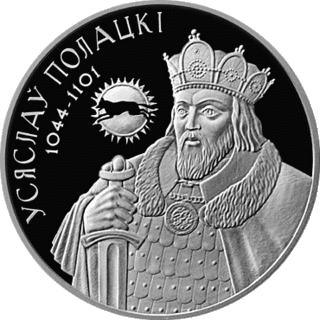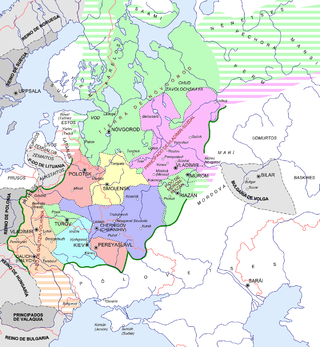The Grand Prince of Kiev was the title of the monarch of Kievan Rus', residing in Kiev from the 10th to 13th centuries. In the 13th century, Kiev became an appanage principality first of the grand prince of Vladimir and the Mongol Golden Horde governors, and later was taken over by the Grand Duchy of Lithuania.

Polotsk or Polatsk is a town in Vitebsk Region, Belarus. It is situated on the Dvina River and serves as the administrative center of Polotsk District. Polotsk is served by Polotsk Airport and Borovitsy air base. As of 2023, it has a population of 79,960.

Vseslav of Polotsk or Vseslav Bryachislavich, also known as Vseslav the Sorcerer or Vseslav the Seer, was the most famous ruler of Polotsk and was briefly Grand Prince of Kiev in 1068–1069. Together with Rostislav Vladimirovich and voivode Vyshata, they created a coalition against the Yaroslaviches' triumvirate. Polotsk's Cathedral of Holy Wisdom is one of the most enduring monuments on the lands of modern Belarus and dates to his 57-year reign.

The Principality of Polotsk, also known as the Duchy of Polotsk or Polotskian Rus', was a medieval principality of the Early East Slavs. The origin and date of state establishment is uncertain. Chronicles of Kievan Rus' mention Polotsk being conquered by Vladimir the Great, and thereafter it became associated with Kievan Rus' and its ruling Rurik dynasty.
The Muscovite–Lithuanian Wars were a series of wars between the Grand Duchy of Lithuania, allied with the Kingdom of Poland, and the Grand Duchy of Moscow, which was later unified with other Russian principalities to eventually become the Tsardom of Russia. After several defeats at the hands of Ivan III and Vasily III, the Lithuanians were increasingly reliant on Polish aid, which eventually became an important factor in the creation of the Polish–Lithuanian Commonwealth. Before the first series of wars in the 15th century, the Grand Duchy of Lithuania controlled vast stretches of Eastern European land, from Kiev to Mozhaysk, following the collapse of Kievan Rus' after the Mongol invasions. Over the course of the wars, particularly in the 16th century, the Muscovites expanded their domain westwards, taking control of many principalities.

The Principality of Ryazan, later known as the Grand Principality of Ryazan, was a principality from 1129 to 1521. Its capital was the city of Ryazan, now known as Old Ryazan, which was destroyed in 1237 during the Mongol invasions. The capital was moved to Pereyaslavl-Ryazansky, later renamed Ryazan.

The inner Principality of Kiev was a medieval East Slavic state, situated in central regions of modern Ukraine around the city of Kiev.
The Pskov Land was a historical region in the north-west of medieval Russia centred around the city of Pskov. It was a vassal state of various Rus' states and had a measure of independence as Pskov Republic before being annexed by the Grand Duchy of Moscow. It had an important role in the trade and conflicts between Russia and its western neighbours.
The Prince of Smolensk was the kniaz, the ruler or sub-ruler, of the Rus' Principality of Smolensk, a lordship based on the city of Smolensk. It passed between different groups of descendants of Grand Prince Iaroslav I of Kiev until 1125, when following the death of Vladimir Monomakh the latter's grandson Rostislav Mstislavich was installed in the principality, while the latter's father Mstislav I Vladimirovich became Grand Prince. It gained its own bishopric in 1136. It was Rostislav's descendants, the Rostaslavichi, who ruled the principality until the fifteenth-century. Smolensk enjoyed stronger western ties than most Rus' principalities.

The Principality of Smolensk was a Kievan Rus' lordship from the 11th to the 16th century. Until 1127, when it passed to Rostislav Mstislavich, the principality was part of the land of Kiev. The principality gradually came under Lithuanian influence and was incorporated into the Grand Duchy of Lithuania in 1404. The principality was reorganized into the Smolensk Voivodeship in 1508. The Principality of Moscow controlled the city from 1514 to 1611, then it was recaptured by the Polish–Lithuanian Commonwealth. Tsardom of Russia recaptured the city in 1654.
The Prince of Polotsk ruled the Principality of Polotsk within the realm of Kievan Rus' or within the Grand Duchy of Lithuania from the mid-9th century to 1307.
The Principality of Drutsk was a small appanage principality of the Polotsk principality and was centred in Drutsk. It was located on a three way stick between Vitebsk, Minsk and Mogilev regions in modern Belarus.

The Principality of Turov, later called the Principality of Turov and Pinsk, also known as Turovian Rus', was a medieval principality of Kievan Rus' from the 10th century on the territory of modern-day Belarus and northern Ukraine. The princes of Turov often served as grand princes early in 10th and 11th centuries. Its capital was Turov (Turaŭ), and other important cities included Pinsk, Mazyr, Slutsk, Lutsk, Brest, and Volodymyr.

Gleb Vseslavich was the prince of Minsk between 1101 and 1119. During his reign Minsk was at war with Kiev and Polatsk. He started the Minsk branch of Prince of Polotsk as son of Vseslav the Seer.

Rogvolod Vseslavich, baptismal name Boris, was the Prince of Drutsk and Polotsk. He was the son of Vseslav of Polotsk, Grand Prince of Rus. Rogvolod probably was named in honor of his ancestor Rogvolod.
The Principality of Vitebsk was a Ruthenian principality centered on the city of Vitebsk in modern Belarus, that existed from its founding in 1101 until it was nominally inherited into the Grand Duchy of Lithuania in 1320. Vitebsk would later fall under the complete authority of Lithuania in 1508.
The Principality of Slutsk was originally a specific Turov Principality of land in the 12th through 14th centuries. It stood out in 1160 and took shape in the 1190s. It became a large feudal principality in the Grand Duchy of Lithuania.
Volodar Glebovich of Minsk was a prince of Minsk belonging to the so-called Polotsk dynasty after the city and the principality Polotsk from where it originated. He was the son of Gleb Vseslavich of Minsk and Anastasia, a daughter of Yaropolk Izyaslavich. Volodar died after 1167, possibly 1176.

The Lithuanian–Muscovite War of 1512–1522 was a military conflict between the Grand Duchy of Lithuania and Ruthenia, which included Ukrainian and Belarusian lands, and the Grand Principality of Moscow for Russian border lands.










